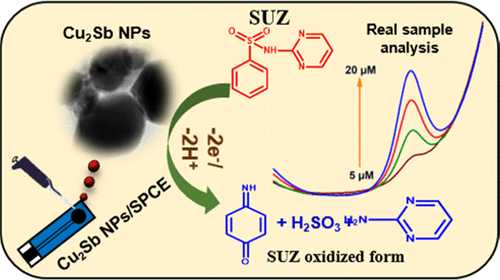当前位置:
X-MOL 学术
›
ACS Sustain. Chem. Eng.
›
论文详情
Our official English website, www.x-mol.net, welcomes your feedback! (Note: you will need to create a separate account there.)
Intermetallic Compound Cu2Sb Nanoparticles for Effective Electrocatalytic Oxidation of an Antibiotic Drug: Sulphadiazine
ACS Sustainable Chemistry & Engineering ( IF 8.4 ) Pub Date : 2020-11-19 , DOI: 10.1021/acssuschemeng.0c05629 Alangadu Kothandan Vivekanandan, Balamurugan Muthukutty, Shen-Ming Chen, Mani Sivakumar, Shih-Hsun Chen
ACS Sustainable Chemistry & Engineering ( IF 8.4 ) Pub Date : 2020-11-19 , DOI: 10.1021/acssuschemeng.0c05629 Alangadu Kothandan Vivekanandan, Balamurugan Muthukutty, Shen-Ming Chen, Mani Sivakumar, Shih-Hsun Chen

|
The synthesis of ordered nanosized intermetallic compounds is of specific interest in tuning their surface properties to obtain enhanced electrocatalytic activity and selectivity, used for various practical applications. In these regards, single crystalline Cu2Sb nanoparticles have been investigated, which are rarely explored in electroanalysis. The Cu2Sb nanoparticle was synthesized using a simple hydrothermal method and applied to the electrochemical sensing of sulphadiazine (SUZ). The nature of the as-synthesized Cu2Sb nanoparticles was confirmed by electron microscopic and spectroscopic studies. A Cu2Sb nanoparticle-fabricated disposable screen-printed electrode (Cu2Sb/SPCE) for a nonenzymatic SUZ sensor shows an enhanced oxidation current with low reduction potential compared to the unmodified SPCE and modified unannealed Cu–Sb SPCE. Under optimum conditions, the differential pulse voltammetry result of the Cu2Sb-modified SPCE revealed a wide linear range from 0.09 to 818.18 μM with a lower limit of detection (70 nm) and higher sensitivity (59.2 μA mM–1 cm–2) toward SUZ. The essential practical feasibility of the proposed sensor was evaluated, and it showed excellent selectivity, stability, repeatability, and reproducibility. Furthermore, the sensor was used to detect SUZ in a cream sample, and it confirms the potential capability of real-time sensing.
中文翻译:

金属间化合物Cu 2 Sb纳米粒子可有效地电催化氧化抗生素药物Sulphadiazine
有序的纳米金属间化合物的合成在调节其表面性能以获得增强的电催化活性和选择性方面具有特殊意义,可用于各种实际应用。在这些方面,已经研究了单晶Cu 2 Sb纳米颗粒,这在电分析中很少探索。使用简单的水热方法合成了Cu 2 Sb纳米颗粒,并将其用于磺胺嘧啶(SUZ)的电化学传感。通过电子显微镜和光谱学研究证实了所合成的Cu 2 Sb纳米颗粒的性质。Cu 2 Sb纳米粒子制造的一次性丝网印刷电极(Cu 2与未修饰的SPCE和经修饰的未退火Cu–Sb SPCE相比,非酶SUZ传感器的Sb / SPCE)显示出增强的氧化电流和较低的还原电位。在最佳条件下,Cu 2 Sb改性的SPCE的差分脉冲伏安法结果显示,线性范围为0.09至818.18μM,检测限较低(70 nm),灵敏度更高(59.2μAmM –1 cm –2)。向SUZ。评价了所提出的传感器的基本实际可行性,并显示出极好的选择性,稳定性,可重复性和可重复性。此外,该传感器用于检测乳霜样品中的SUZ,并确认了实时感测的潜在能力。
更新日期:2020-12-07
中文翻译:

金属间化合物Cu 2 Sb纳米粒子可有效地电催化氧化抗生素药物Sulphadiazine
有序的纳米金属间化合物的合成在调节其表面性能以获得增强的电催化活性和选择性方面具有特殊意义,可用于各种实际应用。在这些方面,已经研究了单晶Cu 2 Sb纳米颗粒,这在电分析中很少探索。使用简单的水热方法合成了Cu 2 Sb纳米颗粒,并将其用于磺胺嘧啶(SUZ)的电化学传感。通过电子显微镜和光谱学研究证实了所合成的Cu 2 Sb纳米颗粒的性质。Cu 2 Sb纳米粒子制造的一次性丝网印刷电极(Cu 2与未修饰的SPCE和经修饰的未退火Cu–Sb SPCE相比,非酶SUZ传感器的Sb / SPCE)显示出增强的氧化电流和较低的还原电位。在最佳条件下,Cu 2 Sb改性的SPCE的差分脉冲伏安法结果显示,线性范围为0.09至818.18μM,检测限较低(70 nm),灵敏度更高(59.2μAmM –1 cm –2)。向SUZ。评价了所提出的传感器的基本实际可行性,并显示出极好的选择性,稳定性,可重复性和可重复性。此外,该传感器用于检测乳霜样品中的SUZ,并确认了实时感测的潜在能力。


























 京公网安备 11010802027423号
京公网安备 11010802027423号